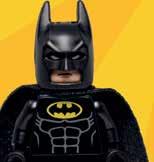












Local Resources
Pediatric Dentistry 21 Schools + Preschools 27
Camps, Arts + Activites 39 Birthdays 46
RAISING GREAT KIDS
Toothless in Seattle 21
Level-up your tooth fairy game with creative ideas shared by ParentMap staffers
The Art of Sharing 29 Pro tips that help kids move beyond the “it’s mine” stage
BOOK BUZZ
New Year, New Books 22 Shiny new titles that will zhuzh up your bookshelf in 2025
EDUCATION
Go Gray Matter 36
How to supercharge your little one’s brain development through play
CELEBRATIONS
Throw a Bookworm Birthday 46
Book-themed party ideas that pair well with cake
Features Managing Motherhood on the Way to Menopause 8
Honest reflections on “the change” — hot flashes, chin hairs and all
The Value of Body Neutrality 17 Resist the pressure to transform your body in the new year, and accept it instead
+ ABOUT The Great Indoors 38 Conquer the longest season — all it takes is a little indoor ingenuity
Play List 44 Fuel your new year adventures with 15 memory-making family outings






It was a typical drizzly fall evening when I first heard a mom push back against the pressure of being body positive. A group of us were gathered at Monster’s studio space in Ballard for a true crime crafting social, swapping birth stories and trading kid hangout secrets when the subject came up. “Sometimes I just want to hate my body and be okay with it,” laughed one mom. And our discussion blossomed from there.
Years later, this conversation inspired our Health and Wellness feature. As writer Gina Rich explains in her article “The Value of Body Neutrality” (p. 17), the concept of body positivity can unintentionally lead to guilt and shame. What better time to question that notion than in the new year — when many of us are tempted to transform ourselves into some new or “better” version than the original. We’re also exploring perimenopause and the challenges it adds when you’re simultaneously parenting young kids. Danielle Hayden writes with humor and honesty about The Change (p. 8).
If the ever-present cacophony of kids claiming “It’s mine!” over winter break has you running for the secret chocolate stash you’ve squirreled away in the closet, be sure to read Julietta Skoog’s article “The Art of Sharing” (p. 29). Her practical tips are lifesavers. And the folks at UW’s Institute for Learning & Brain Sciences share the secrets to supporting brain development in kids (p. 29). Hint: It’s all about play!
Conquer the longest season in the Pacific Northwest with creative ways to pass the time indoors (p. 38). Kathryn Mueller has fieldtested 10 local outings that will keep everyone dry and entertained until the sun makes its triumphant return in … well, your guess is as good as mine. Our January Play List (p. 44) will help fill in the gaps and hopefully inspire new family adventures in 2025, too. Finally, our own ParentMap staffers share their favorite (not to mention budget-friendly) things to leave under the pillow when your kid is toothless in Seattle (p. 21).
Here’s to a wonderful New Year!
— Allison Sutcliffe, managing editor
JANUARY 2025, VOL. 22, NO. 1 PUBLISHER
Alayne Sulkin
EDITORIAL
MANAGING EDITOR
Allison Sutcliffe
SENIOR EDITOR
Kristin Leong
ASSOCIATE EDITOR
Kari Hanson
FAMILY FUN EDITOR
Meredith Charaba
CALENDAR EDITOR
Julie Dodobara
COPY EDITOR
Sunny Parsons
CONTRIBUTORS
Gemma Alexander, Amelia Bachleda, Ph.D.,
Tiffany Doerr Guerzon, Danielle Hayden, Kathryn Mueller, Gina Richd
DIGITAL MARKETING
MARKETING DIRECTOR
Lindsey Carter
EMAIL MARKETING SPECIALIST
Devon Hammer
SOCIAL MEDIA SPECIALIST
Brooke Collins
ADVERTISING SALES + PARTNERSHIPS
DIRECTOR OF COMMUNITY
PARTNERSHIPS + ADVERTISING SALES
Jessica Collet
SENIOR ADVERTISING AND PARTNERSHIPS MANAGER
Ida Wicklund
EVENTS + COMMUNITY
PARTNERSHIPS SPECIALIST
Brenna McCown
CLIENT SERVICES + DESIGN COORDINATOR
Angela Goodwin
ADVERTISING CLIENT SERVICES SPECIALIST
Mallory Dehbod
DIGITAL ADVERTISING + MARKETING SPECIALIST
Taryn Weiner
PRODUCTION COORDINATOR
Tamryn Nell
ART + PRODUCTION
SENIOR DESIGNER
Amy Chinn
ADMINISTRATION
BUSINESS MANAGER
Carolyn Brendel
OPERATIONS ASSISTANT
Erika Widjaja
PARENTMAP EDITORIAL ADVISORY BOARD
Benjamin Danielson, M.D. CLINICAL PROFESSOR, UW SCHOOL OF MEDICINE PRACTICING PHYSICIAN, UW MEDICINE
Joan Duffell RETIRED EXECUTIVE DIRECTOR, COMMITTEE FOR CHILDREN
John Gottman, Ph.D. THE GOTTMAN INSTITUTE PROFESSOR EMERITUS, UNIVERSITY OF WASHINGTON
Laura Kastner, Ph.D. PSYCHIATRY + BEHAVIORAL SCIENCES, UNIVERSITY OF WASHINGTON
Bea Kelleigh VICE PRESIDENT, DOVETAILING, LLC
Yaffa Maritz, M.A. FOUNDER, LISTENING MOTHERS + COMMUNITY OF MINDFUL PARENTING
Daniel J. Siegel, M.D. EXECUTIVE DIRECTOR, MINDSIGHT INSTITUTE
“24”
“My Favorite Murder”
“The Lord of the Rings” trilogy and “Fleabag”
“The Hunger Games” series
“The Killing” and “The Handmaid’s Tale”
CONTACT
INFORMATION
Advertising information 206-709-9026 or advertising@parentmap.com Fax 206-709-9031
Calendar submissions calendar@parentmap.com
Editorial submissions editor@parentmap.com
Distribution distribution@parentmap.com
Administration 206-709-9026, parentmap.com
Subscriptions subscriptions@parentmap.com
Subscription rate 1 year: $12














Tiny bird backpacks have big potential

In a very cute and high-tech twist on birdwatching, researchers at the University of Washington outfitted hummingbirds with tiny “backpack” trackers weighing about as much as a Tic Tac to study the birds’ movements. The data could help expand protected areas in the region, ensuring these pint-sized pollinators don’t become extinct.
Surprise! It’s positive pregnancy test time
If it feels like you’re RSVP-ing to an endless string of summer birthday parties, you’re not imagining things — most U.S. babies make their debut as days start getting longer and warmer. Count back nine months and it’s clear that the winter chill creates some heat between the sheets for many couples. Turns out, humans are just playing by nature’s seasonal rules, perhaps fueled by a little festive spirit in the air and some New Year’s Eve bubbly.

Bring back Pizza Hut’s BOOK IT! challenge for all
To the horror of book nerds across Seattle, Statista recently revealed that just 5 percent of Americans read more than 12 books over the last year. Meanwhile, nearly 30 percent admitted they hadn’t cracked a single title at all.

According to a study by the National Library of Medicine, your odds of keeping a New Year’s resolution might hinge on whether you’re focusing on doing more of something good versus doing less of something bad. Turns out, “eat more vegetables” is a bigger winner than “stop inhaling Sour Patch Kids.” Participants in the study showed a success rate of 59 percent for proactive goals, compared to a 47 percent rate for restraint-focused goals. So, if you’re serious about lasting change, you might want to start with the carrot (literally), instead of the stick.
Scarlet macaws may symbolize fidelity, but when it comes to parenting, they’re more meh than model. Texas A&M researchers discovered these colorful parrots purposefully neglect their youngest chicks, even when food is abundant, favoring only one or two chicks to survive. It’s not a sibling rivalry or scarcity issue — mom and dad just stop feeding the runts. Thankfully, scientists are stepping in to rescue these forgotten chicks, proving that even nature’s most vibrant show-offs could use some parenting intervention.

By Kristin Leong, M.Ed.

Teens today are burdened by more than just cell phones
According to recent findings by Pew Research, parents are convinced that being a teen today is harder than ever. The main culprit? It’s in the palm of all of our hands. Two-thirds of parents point the finger at technology, with 41 percent specifically blaming social media for everything from body dysmorphia to toxic interactions. Other factors that topped the list: More expectations than previous generations and the sense that the world has changed for the worse in recent years.



















www.kongacademy.orginfo@kongacademy.org
















By Danielle Hayden
How one Seattle-area mom is writing, being a wife and raising her daughter through hot flashes
While lying next to my daughter Aria and chatting before saying goodnight, she joked, “Mommy, is that a beard?” My everobservant 7-year-old had noticed the tiny, dark strand of hair sprouting from my chin. I laughed. “No, it’s not a beard.” She narrowed her eyes and pointed, grinning before asking, “Is it gonna be like really long?” We laughed again, and I explained that this was just more of what Mommy’s body has been going through as she gets older, that it’s been going on for a while, and that I pluck the hairs even though it is uncomfortable to do so. As she settled down to sleep, my smile faded and I became
more pensive, reflecting on these changes and how to communicate this phenomenon to her.
Entering perimenopause at age 35 is not unheard of, but I was definitely not expecting it when it hit. According to the Centers for Disease Control and Prevention, this transition usually begins between ages 45 and 55, with the average age in the United States being 52. But some begin later, and others, as in my case, start to transition earlier. I certainly began before anyone else I know and before the other women in my family had in the past.
At almost 37, I’ve had more than a year of symptoms, from occasional issues such as breakouts and brain fog to chronic issues like insomnia, night sweats and not wanting intimacy with my husband. At least the era of slight urinary incontinence I was experiencing earlier this year (so fun!) seems to have stopped for now.
Although this phase of life can feel isolating, I know that I am not alone. Menopause does not discriminate; it is an inevitable part of life for millions. But that doesn’t mean that the symptoms of menopause are a universal experience. Quite the contrary: Symptoms can be mild, severe or somewhere in between, with much more nuance than we might think.
Officially, menopause is determined after a menstruating woman doesn’t have a period for one year. However, there is no official diagnosis for perimenopause — the transition to menopause — merely a series of clues based on a combination of physical and emotional symptoms, such as difficulty in sleeping, changes in mood, difficulty in concentrating and hot flashes.
In general, there seem to be fewer resources and less awareness of perimenopause. Recently, I went with Aria to the drugstore, mainly to buy Estroven, an over-the-counter medication to treat menopause symptoms. I was frustrated but not surprised to discover that although the chain carried four different kinds of Estroven for menopause, the only
kind of Estroven that addresses symptoms of perimenopause was not stocked. Seems I will have to keep ordering online.
There is often a cycle of silence around bodily changes. I didn’t talk much with my own mother about the changes she was going through in her late 40s. I remember her mentioning hot flashes, and I recall how she would roll down the windows even during Michigan winters. I felt annoyed that she ignored my shivering, but I realize now that I was ignoring the very real surge of heat going through her body. In retrospect, I also wonder if any of the tension between us that I dismissed as personality differences, teenage angst and normal mother-daughter quarrelling may have been connected to “the change” as
There is often a cycle of silence around bodily changes.
well. But I also don’t want to be reductive or dismissive by blaming hormones. Society does enough of that to us.
I want to be more open with Aria than my mom was with me, and my grandmother was with my mother. That seems to be the trend with each generation. Nearly 9 in 10 (88 percent) of millennial parents say their parenting style is different from how
in


• The Let Grow Experience Curriculum builds independence and responsibility through real-life activities as homework for K-12th grades.
• The Let Grow Play Club brings old-fashioned, mixed-age, free play to your local school or park.
• The Independence Kit, Independence Inventory, and Parent Play Club Guide are Family Editions to start Let Grow at home.
FREE MATERIALS READY TO SHARE OR PRINT
Visit letgrow.org and start your journey to independence today!





I can help support you in finding your emotional balance for you and your family. Contact me today to set up a FREE 20 minute call to get started.

continued from page 9
FEATURE MOTHERHOOD AND MENOPAUSE they were raised, and the top difference is engaging in open communication. As more people decide to have children later in life, the number of mothers raising school-age children while going through perimenopause or menopause continues to increase.
Parents navigating major hormonal changes may face additional challenges. “You’re already not feeling great, and then you have little children who demand a lot of time and energy from you that you may or may not have. And then also sleep; they’re waking you up and your sleep is already disrupted because you’re either having night sweats or your sleep is disrupted from hormonal changes,” says Naomi Busch, M.D., a certified menopause practitioner and board-certified family medicine physician with Seattle Menopause Medicine in Green Lake.
I understand this well. I have even less energy to play with Aria, and I sometimes worry that she will feel rejected, even as I explain I’m not feeling my best. These days, it is normally my husband who is more active with her. I selfishly wish she could remember the first few years of her life when I was the one who played with her every day, never denying her indomitable will to frolic.
In fact, these days I don’t want to do as much in general. This listlessness is exacerbated by fatigue, brought on by overall tiredness from hormone shifts and insomnia. I have been a night owl for decades, but this exhaustion goes beyond a preference for the nocturnal. Occasionally, it really does hurt to get up; achy joints and muscles are a symptom of perimenopause as well. I get migraines more often now, too.
Although I am trying to be more open with my daughter, I am also keenly aware that I need to watch what I say around her about my body as I’ve gained weight over the past year. Even though I know that weight gain is another common effect of perimenopause, along with overall shifts in body composition, this change continues to affect how I feel about myself, and the pictures I take, and the ill-fitting items in my wardrobe that I stubbornly refuse to part with just yet.
Although curves are more accepted in mainstream society than they were when I was child, that type of weight is distributed in a very specific, hourglass-shaped way — unlike, say, the double chin I am
getting (the same chin that has the three tiny hairs growing out of it).
Speaking of hair, the hair on my head seems to be at a standstill, despite my best efforts to grow it out. Thinning and slower-growing hair also happen for many people in perimenopause. Sometimes I even get a few pimples these days. Acne is something I haven’t had to think about for 20 years, since “Friends” went off the air and the iPad mini came out.
However, the worst part of perimenopause has been the brain fog. I have never been particularly confident in my looks to begin with, so the changes to my appearance are disappointing but not devastating. My physical symptoms are perhaps annoying, but not extreme. But my intellect, my sharp wit — those were things I could always count on. But ever since the onset of per-
imenopause, my mental acuity has taken a hit. It is harder to focus. I am slower to recall things, even though I have always been known for having an impeccable memory. I sometimes lose my words or am slower to mentally calculate sums that used to take me only seconds.
As neuroscientist Lisa Mosconi, Ph.D., explains in her best-selling book “The Menopause Brain,” cognition is directly im-
As unprepared as I felt when the first perimenopause symptoms hit, many professionals are likewise not equipped with sufficient knowledge. There is very little There




pacted by a decline in estrogen. “Notably,” she writes, “the menopause repertoire features at least as many brain symptoms as bodily ones.” I see now that I was more prepared for pains in my less than perky breasts than I was for neurological shifts.












continued from page 11
training for this transition, and only 6.8 percent of doctors report feeling “adequately prepared” to address menopause, according to a 2019 study.
But I am learning more all the time, and I am facing it head-on with my family by my side. I have always been introverted, but these days I socialize even less, preferring to watch movies at home with my family. My emotional sensitivity has also increased, but I have chosen to lean into my feelings even more intensely. I have been reading about menopause through books and more Google searches than I can count. In addition to Estroven, I take more vitamins and supplements and try to eat healthier. Sometimes meditation helps me fall asleep (even though I cannot always stay asleep). Exercise is supposed to help, but I haven’t resorted to that yet!
Perimenopause might seem as though something is coming to an end, but if you let it, it can also mark a beginning.

I have also spoken a bit with my mother, mother-inlaw, grandmother (my 94-year-old Nana, who will not even say the word “pregnant”) and an older friend who has a child at my daughter’s school. After they got over their surprise because of my relatively young age, we swapped stories and laughs. I have started thinking more about my legacy. Perimenopause might seem as though something is coming to an end, but if you let it, it can also mark a beginning.
How women can support themselves through perimenopause and menopause
• Enacting a sense of agency can be empowering. Speak to your health-care provider sooner rather than later. Fortunately, mine was supportive, knowledgeable and took my concerns seriously. Your physician may recommend medication, hormone replacement therapy or something else.

Despite the bouts of sadness that can strike perimenopausal and menopausal women, studies show that women are, on average, happier and more satisfied with their lives after menopause.
• Busch advises that we ask ourselves, “How have you been communicating about your own needs?” Instead of bottling up your feelings and trudging through it (or worrying about being a burden), as so many do, Busch suggests being open and honest with those close to you if you haven’t been feeling well or feeling like yourself.
• One piece of sage advice offered by Busch is something I hadn’t even considered: bringing awareness to the workplace. Check with the HR department to see if the thermostat can be adjusted. If you wear a uniform, ask if you can switch to cotton instead of polyester, for more breathability. Busch also recommends checking to see if employer-sponsored insurance will cover menopause medication and treatments. Some of Busch’s patients have had to pay $140 a month or more out
of pocket, something she hopes will shift: “We as a society should try to support the women in our lives by advocating for those types of benefits.”
• Give families, especially partners, a chance. They are often more capable of understanding than we give them credit for.
How families can support perimenopausal and menopausal loved ones
• Be supportive, believe your loved one and be patient. Try not to make jokes at their expense or belittle them. Instead, be sensitive to what they are sharing about what they’re going through.
• It’s helpful for partners to take over some of the household responsibilities and caretaking, perhaps offering to share the load of waking up for nighttime feedings or to soothe away bad dreams.












It’s not all bad
Although much of the often limited conversation around menopause is frequently gloom and doom, I like the idea of more gray hairs (I have a few already), along with the prospect of no longer menstruating and never having to buy period products again. Although it could turn out that my daughter may be starting her period just as I’m ending mine.
While he doesn’t “get it,” my husband has been pretty supportive, allowing me more time to rest when I need to, and being more active in child care.
Despite the bouts of sadness that can strike perimenopausal and menopausal women, studies show that women are, on average, happier and more satisfied with their lives after menopause. I would hope so, since 40 percent of most women’s lives are lived after menopause. For me, I would say that I am the happiest I’ve ever been these days, and I am still in the thick of things. ■
Danielle Hayden is a Seattle-based writer and editor. In addition to words, she also adores film, music, travel, learning new things, deep or intellectual discussions, and the Oxford comma. Two things she values greatly are art and authenticity.


Scan the QR code below to sign up for Seattle Children’s Healthy Tides newsletter. Each issue shares timely tips to keep your family as safe and healthy as they can be.
Hope. Care. Cure.™



The answers you need, from experts you trust
Let’s face it — parenting is tough, especially without a manual to guide you through every twist and turn. That’s where ParentEd Talks come in. ParentMap is excited to offer a transformative series of parent education webinars, designed to provide the guidance you need to support your child’s development. Turn
FEATURING
Jonathan Haidt, Ph.D., author of “The Anxious Generation”


Register for the entire series for just $50 or individual talks for $10 each: ParentMap.com/talks




Q&A hosted by Laura Kastner, Ph.D.
ParentMap is honored to present Laura Kastner as the series host. Kastner is the author of numerous parenting books, including the acclaimed “Getting to Calm” series, and a clinical professor of psychiatry and behavioral sciences at the University of Washington. Kastner will lead each speaker through a live audience Q&A, addressing your most challenging parenting questions.




Navigating Neurodiversity: Strength-Based Support for ADHD Kids
Jan. 16, 2025
Confident Conversations: Guiding Kids Through Puberty and Adolescence
Feb. 5, 2025
The Lost Art of Civility: Raising Respectful Kids
Feb. 25, 2025



From Chaos to Calm: Compassionate Discipline for Spirited Kids
April 1, 2025
Let Go and Let Grow: Raising Confident, Independent Children
May 6, 2025
Nurturing Resilience: Essential Coping Skills for Kids
June 5, 2025
One additional speaker will be announced soon! Harmony at Home: Successfully Navigating Parent-Child Differences
March 20, 2025


A much-needed, new perspective is challenging the notion of body positivity
By Gina Rich
Growing up in the 1980s, I was a typical angsty adolescent who worried about homework, grades and fitting in with peers. But most of all, I worried about how my body looked.
My calves were knobby, my hair frizzy from countless hours in chlorinated pools. I lamented my splotchy skin and my short, stocky frame, which looked nothing like the dewy-faced, willowy models in Seventeen magazine.
“Body neutrality is letting your body look and be the way it is, and it doesn’t have to mean anything.”
I was close to my mother, an unfussy eater who never, to my knowledge, went on a diet. So whenever I complained about my appearance, my mom didn’t try to talk me out of my feelings. Instead, her usual reaction was “Honey, your body is just fine.” Then we’d move on.
Decades later, I have two daughters of my own, and we’re navigat-
ing the rocky terrain of body image together. So recently, when I heard the term “body neutrality” on a podcast, I thought of my mother’s relaxed, nonjudgmental approach — and I wanted to learn more.
What is body neutrality?
The concept of body neutrality wasn’t widely known until 2015, gaining popularity after Anne Poirier used the term in her book “The Body Joyful.” Today, health coaches and fitness instructors are embracing it, as are celebrities, including musician Lizzo and actor Jameela Jamil.
“Body neutrality is letting your body look and be the way it is, and it doesn’t have to mean anything,” says Pam Moore, a certified intuitive eating coach and occupational therapist in Colorado.
We may dislike the shape of our noses or how our jeans fit, but we still treat our bodies with respect — and our self-worth isn’t connected to how our bodies look or perform.
“From a clear place, you can see that your body is the least interesting and important thing about you,”

FEATURE

When you purchase a Keep Kids Safe license plate, you help keep children of all ages healthy and safe.


continued from page 17
says Jessi Kneeland, a North Carolina body image coach and author of the book “Body Neutral: A Revolutionary Guide to Overcoming Body Image Issues.”
Kneeland compares body neutrality to walking past a messy or unattractive part of your home. You might think the room could use a fresh coat of paint or deep cleaning, but this thought doesn’t ruin your day.
Similarly, parts of your body might bother you, but “they don’t have the power to cause you inappropriate suffering,” says Kneeland.
There is an unwritten rule among women my age: We must not speak negatively about our bodies.
Notably, body neutrality differs from body positivity, which dates back to the 1960s and promotes the idea that all bodies are beautiful. The movement began when the National Association to Aid Fat Americans (now called the National Association to Advance Fat Acceptance) advocated for people in larger bodies.



Over the years, body positivity has been a recurrent theme in popular culture, from Dove’s Real Beauty advertising campaigns to ubiquitous social media hashtags like “body-positivity” and “love your body.”
The body positivity problem
Though body positivity can be empowering, it’s not for everyone — and many people have been harmed by it, says Kneeland. If someone has struggled with body image for years, telling them to love their curves and stop caring what others think is far from an instant cure.
One downside of body positivity is that it can layer guilt and shame on top of whatever challenges a person is already facing. For example, when you don’t like what you see in the mirror, the next thought becomes, “Oh my God, I’m supposed to be body-positive; I’m not supposed to think that,” Moore says.




There is an unwritten rule among women my age: We must not speak negatively about our bodies. If one of us should say something degrading about how we look, the knee-jerk response is “But don’t say that! You’re
beautiful!” It’s almost verboten to describe ourselves as anything less than stunning.
But too often, that approach feels inauthentic and doesn’t help. Considering the narrow definitions of beauty we’ve absorbed throughout our lives, “it’s unreasonable to imagine that you’re going to flip a switch one day and just suddenly be, like, ‘I love my body,’” says Moore.
At its core, body positivity “still focuses on the superficial of “I look this way,” as opposed to ‘I am a good person,’ or ‘I have all these good qualities,’” says Marley Blonsky, co-founder of All Bodies on Bikes, a body-neutral, inclusive cycling community based in Arkansas.
“It encourages people to love inconsequential parts of their bodies,” says Blonsky.
If your child (or grandchild) says they hate their stomach or that their thighs are too big, ask why they feel that way or what prompted the thought.
Practicing body neutrality
Body neutrality can help us relate to our physical selves differently. While getting to that place takes time, we can move toward it.
“The first step is to become conscious of what meaning you’re assigning to the thing you dislike,” says Kneeland. For instance, someone who hates their legs may believe that thin, toned legs will translate to being accepted, desired and loved. But getting those needs met and feeling worthy of love has nothing to do with our bodies.
When talking with kids, adopt an approach
of “nonjudgmental curiosity,” says Moore. If your child (or grandchild) says they hate their stomach or that their thighs are too big, ask why they feel that way or what prompted the thought.
“I think the fear is that if we go there and talk about it, we’ll somehow make it worse,” she says. But with my daughters, who are 11 and 13, I’ve found it helpful to invite more questions.
Another way to shift your thinking is to look critically at mainstream beauty standards and point out unrealistic examples. If you’re watching a show where many actors look

continued from page 19
like supermodels, talk about why that might be the case, says Moore.
People may have had surgical or cosmetic work, or perhaps they’re genetically in smaller bodies. Is that an Instagram photo of what someone looks like, or are they wearing a lot of makeup and using a filter? What we consider beautiful may not be real.
Moore also suggests using “add-on” thoughts to help counter the shame spiral that can happen when we’re focused on something we dislike about our bodies.
If we hate how our stomach looks on a particular day, it’s easy to slip into moral judgments: for example, we’re not disciplined enough with exercise or don’t eat the right foods.
An alternative response is to follow up that first thought with a more neutral statement that’s still true. For example, we might try “I don’t love my stomach today — and I don’t have to,” says Moore.
Ultimately, says Blonsky, “None of us are guaranteed these bodies tomorrow, so we should focus on other aspects of ourselves that will still be here.” I’m keeping that advice in mind.
Though my body image struggles are different now than when I was younger, there are still challenges. And in a culture saturated with highly positive and negative narratives about our bodies, I want my kids to know there is another option.
On a recent night, my younger daughter
and I were in the bathroom undertaking some skin care. “Mom,” she said, “is it okay if I don’t like my stomach?” She looked wary as she eyed her midsection.
I paused, tempted to tell her that this was silly, that her body was beautiful and perfect. But instead, I said, “Yes, it’s okay not to always like your body. Look, I have a big scar on my tummy that I don’t love. But your body isn’t the most important thing about you — far from it.”
She nodded, satisfied. And we moved on with our evening. ■
Gina Rich is a well-caffeinated mom who writes about parenthood, health and the natural world. Connect with her on her website.

These sweet ideas will put a smile on your (toothless) kid’s face
By Kari Hanson
It can happen in the middle of the night, during dinner or even at school. Sometimes it’s a surprise, sometimes it has been anticipated for days, even weeks. You guessed it, I’m talking about losing a baby tooth..
Kids typically lose their baby teeth between the ages of 6–12, when magic is still (kind of) real, small items can be thrilling and kids are still making holiday wish lists that don’t just say “money.” Add a little magic to your typical Tooth Fairy routine with these creative ideas, courtesy of our ParentMap staff.
• “I downloaded a tooth fairy receipt from Etsy that I can customize for each lost tooth (date, quality of tooth, etc.). Then
I sprinkle some fairy dust on it, roll it up and tie it with a bow and leave it with a fairy-dusted one-dollar bill.” — Brenna
• “My mom used to write a tiny note from the tooth fairy telling us what our tooth was used for in Tooth Fairy land. The note was rolled up and tied with a string and left in a little jar under our pillow. We got some change too, but the note was always the best part. I did the same thing for my kids when they lost their teeth.” — Kari
• “The Tooth Fairy just visited our house last night! She left one dollar, and she left a note one time, courtesy of Delta Dental’s website.” — Mallory

• “In South Africa we had a “tooth mouse” and we left our teeth in our slippers. We would get a five rand coin which is equivalent to about 28 cents in America. We were told the mouse used the teeth to build houses for other mice.” — Tamryn
• “When my son was younger and really into cars, the Tooth Fairy would leave one Matchbox car. As a kid, my dad would just leave us whatever spare change he had. I loved it because it was always totally random and could actually add up to a nice, tidy sum (at least that was my perception as a kid!).” — Julie ■





From age 0 to 18, our team helps guide you and your child through their developmental stages, starting from your baby’s rst tooth.


There’s a reason gyms and yoga studios are packed with new recruits every January. There’s just something about the new year — combined with the post-holiday slump and very short days — that makes people want a fresh start. Little kids have a different sense of time, but it’s never too early to start learning about healthy choices and trying new things. Here are ParentMap’s choices of new books for a healthy new year.

“Frankenstein: Accessible Symbolised Edition” is one in a series of adapted classics from Every Cherry, a new British publisher dedicated to making literacy accessible to special needs students. Symbolized editions incorporate dyslexia-friendly fonts and paper, glossaries, high-low reading levels suited for neurodiverse readers, and graphics above keywords to boost reading comprehension. They also come with free ASL videos. $8.20, special needs adaptation.

“The Self-Regulation Workbook for 3- to 5-Year-Olds: Play-Based and Creative Activities to Build Coping Skills and Handle Big Emotions” by Abbré McClain and Jacqueline Salazar is an evidence-based workbook filled with playful and creative activities to help foster self-regulation skills necessary for healthy emotional development in rapidly growing preschoolers. $17.95, ages 3–5.

“In Praise of Mystery” by Ada Limón is an illustrated picture book of the U.S. poet laureate’s poem that was engraved on the Europa Clipper spacecraft. It celebrates curiosity and exploration while showing how the unknown can teach us about ourselves. $17.09, ages 4–8.
“Great Idea Malia!” by Alliah L. Agostini explores the power of ideas as Malia
comes up with some less than successful ones for helping her mom deal with the challenges of a new job. $18.99, ages 4–8.

“The Pie Reports” by Hayley Lowe deals with illness and depression in a gentle, age-appropriate way. Noor and Granddad share their love of pie and keep in touch through weekly video chats. But when Granddad’s blue days get worse and he starts missing calls, Noor decides to write down her pie reports, holding space for Granddad until he feels ready. $18.49, ages 6–8.

“A World of Flavor: A Celebration of Food and Recipes from Around the World” by Gabrielle Langholtz is an innovative cookbook that inspires kids to explore new foods with more than 40 easy, kid-friendly recipes from countries around the world, each paired with fun facts and cultural information. $26.76, ages 7–10.

“Mishka” by Edward van de Vendel starts with a new pet, Mishka, whose arrival sparks storytelling about Roya’s family’s journey from Afghanistan to the Netherlands. With the story told from different family members’ points of view, Roya gets a new perspective on family history. $15.99, ages 7–10.
By Gemma Alexander

“Chickenpox” by Remy Lai is a graphic novel about Abby, who gets stuck at home with her four annoying younger siblings when her friend gives them all chicken pox. Kids who are old enough to remember pandemic lockdowns will sympathize with Abby’s desire to be anywhere else. $14.99, ages 8–12.

“Deer Run Home” by Ann Clare LeZotte is a novel in verse using ASL grammar about Effie, who is deaf and the only one in her family who speaks sign language. But Effie has a secret that needs to be told. Although it deals with abuse, this story is sensitively told by a deaf author. $17.66, ages 10–14.

“Compound Fracture” by Andrew Joseph White is a violent, political story for teens. Miles Abernathy is a trans teen with socialist ideals who tries to end a century-old blood feud between his coal-mining family and corrupt local authorities in West Virginia. “Compound Fracture” was chosen by Publishers Weekly as one of the best YA books of 2024. $17.99, ages 14 and older.

“Twenty-Four Seconds from Now …” by Jason Reynolds treats Black boys and their emotional lives with all the nuance and sensitivity Reynolds is known for. Neon is going to consummate his relationship with first love Aria — if he can stop freaking out. As the story is told in rewind, readers see the young couple’s history, from embarrassing meet-cute to 24 seconds before they begin a new, more adult phase of their relationship. $18.59, ages 14 and older. ■
For kids and adults alike, our emotions show how we’re feeling as we respond to experiences. We can express ourselves verbally, with words. At other times, we show our emotions in non-verbal ways — such as blushing, raising our eyebrows or having our eyes fill with tears. And when we express ourselves both verbally and nonverbally, that makes it extra clear how we’re feeling.
Dealing with big feelings and expressing emotions in appropriate ways are important life skills. People who have these strong social skills tend to have more self-confi dence, better physical health and greater success at school and work. They also have healthier personal relationships, which are essential for a happy life.
It takes practice to develop these skills. The process requires what’s called ‘emotion coaching’ and — you guessed it! — parents make the best coaches. As parents, it’s our job to model healthy ways to express emotions and teach our kids to do so. Emotion coaching helps a child avoid acting out in negative ways when they are distressed. It gives them better options than behaviors such as screaming, saying hurtful things, slamming doors, breaking things, or striking something or someone.
Emotion coaching requires a parent to tune in to their child and be aware of their emotions. This starts with listening carefully and with compassion. Then, we can let them know that we understand
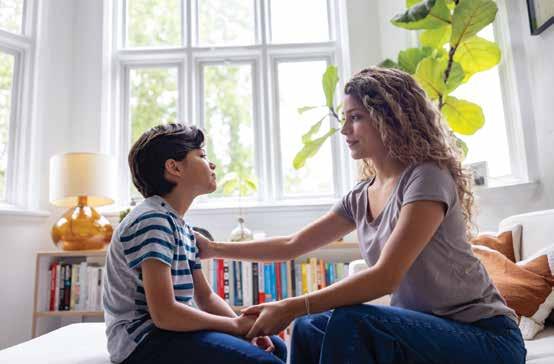
and accept their feelings. We can help them name their big emotions using words they can understand — like sad, angry, disappointed and frustrated. And we can help them fi nd better ways to solve a problem or deal with an upsetting situation.
Of course, not every big emotion requires coaching. Expressing intense feelings can be wonderful — like shouting with delight or laughing until we feel weak. And having a good cry when we’re terribly sad can be helpful and healing.
Seattle Children’s offers a free, ondemand Behavior Basics class to help parents develop skills that can improve a variety of behavior challenges. Targeted to parents of kids ages 5 to 12, this virtual course features short videos of experts sharing practical tips to use at home, plus a downloadable workbook. Scan the QR code to the right to learn more.
When a child suddenly expresses big emotions in a negative way, it can be upsetting for everyone. However, when we validate a child’s feelings and help them use their coping skills, it becomes an opportunity for meaningful teaching — and even more closeness!
SCAN TO LEARN MORE

Does your family eat from the rainbow? If you enjoy a colorful variety of produce, the answer is yes! Eating fruits and vegetables in a range of colors ensures you’re getting essential vitamins, minerals and nutrients — which is key to protecting your child’s heart health now and in the future. While we may associate fresh produce with summer, it’s available all year round. Go for locally grown, in-season produce when you can; farmers’ markets are great for sampling something new. In-season winter produce includes Brussels sprouts, bok choy, kale and cabbage. And grocery stores always offer colorful fall crops like apples, beets, carrots, sweet potatoes and squash — plus citrus fruits grown in warmer climates. Why not scout the fresh produce with your child, then make something tasty like a broccoli quiche or an apple carrot muffin? If fresh produce isn’t easily available, frozen fruits and veggies are nutritious, convenient and budget-friendly — and ideal for smoothies, soups, stir-fry dishes and baked goods.
SCAN TO LEARN MORE
When a child is sick with a cough and/or a cold, it’s natural to want to treat all their symptoms in hopes of making them get well faster. But in fact, treating symptoms doesn’t shorten the illness — and oftentimes, treatment isn’t needed.
The American Academy of Pediatrics warns that cough and cold medicines can cause serious harm to young children. Potential side effects include slowed breathing, which can be life-threatening, especially for infants and young children.
• For babies and children under 4, these over-the-counter medicines are not recommended.
• For children ages 4 to 6, use cough and cold medicines only when recommended by your child’s doctor.
• For kids older than 6, these medicines can be used only when you carefully follow the instructions on the package and use the dosing tool that came with the product.
Most sniffles and coughs don’t require a doctor’s visit. And rather than treating symptoms, it’s best to treat a child based on how they’re doing: their energy, appetite and comfort. If you’re not sure, the Seattle Children’s Symptom Checker is a handy resource — bookmark it with the QR code below. This easy-to-use guide will help you determine how sick your child is, when to call the doctor, and how to treat your child at home when it’s safe to do so. You know your child best. If your child doesn’t look or seem right, or if you have any questions, talk with their doctor.
SCAN TO LEARN MORE

Quality sleep is essential for everyone. It restores us both physically and mentally and is key to our overall wellbeing. Sleep hygiene refers to habits and routines that make it easier to fall asleep and stay asleep. Especially during the school year, stick with consistent bedtimes and wake times every day of the week. (Weekend late nights and sleeping in can disrupt healthy sleep patterns for days after.) Establish a soothing bedtime routine to help your child relax. Turn off all screens and avoid physical exercise and big meals in the hour or so before bedtime. Depending on your child’s age, a cozy nightly routine might include bathing, reading a story or getting a back scratch. Be sure your child has clean, comfortable sleepwear and bedding, and that their room is dark, quiet and screen-free. Quality sleep is an investment in our health and happiness — and it’s always worth the effort!
SCAN TO LEARN MORE, INCLUDING HOW MUCH SLEEP YOUR CHILD OR TEEN NEEDS


Snow sledding is fun for the whole family, as long as it’s done safely! Ski areas offer the best sledding thanks to long, thrilling runs that are wellmaintained and free of obstacles. For neighborhood sledding, be sure there are no collision hazards like trees, poles, fences and parked cars. And of course, a sledding path must never intersect a street with car traffi c. Helmets are a must: a winter-sport helmet is best, but a bike helmet is better than nothing. And always sled feet fi rst, never headfi rst. Be sure everyone has clothing and gear that keep them warm, dry and comfortable. Sledding is an allages sport, so be sure you’re there to supervise and take some runs yourself!
SCAN FOR WINTER SAFETY TIPS
Growing bodies need specialty orthopedic and sports-injury care to get them back to the activities they love, as safely and quickly as possible. Seattle Children’s specializes in treatments that are proven to have the best results for children whose bones are still growing.
Because kids keep growing well into their teens, they often need different treatment than adults do — especially relating to their growth plates. Children and young teens have these patches of growing tissue near
get the best images, thanks to low-doseradiation X-ray machines.
All care teams at Seattle Children’s have special training in the physical, emotional and social needs of young people. Along with treating the immediate concern, these caregivers consider all the possible longterm results for children as they grow into adulthood. And even young adults who are done growing benefit from seeing pediatric experts who are tuned in to their overall development.






the end of the long bones. Growth plates determine how long a child’s bones will be once their bodies mature; damage to these areas can affect their growth permanently.
Another reason to see a pediatric specialist is because children’s bone fractures heal differently than adults’ fractures do. For example, sometimes a child’s crooked fracture will straighten out as they grow. This means that a child might need only a cast, whereas an adult with a similar injury might need surgery.
If a child needs imaging that uses radiation, Seattle Children’s has the most boardcertifi ed pediatric radiologists in the Northwest. And its hospital and clinics use the least possible amount of radiation to
It’s reassuring to know that Seattle Children’s sees over 40,000 patients each year for orthopedics care — more than any other pediatric hospital in the Pacifi c Northwest. And it has performed more than 10,000 orthopedic surgeries and procedures in the last 5 years; that’s more than any other hospital in the region.
SCAN TO LEARN MORE
Please check seattlechildrens.org/classes for the latest information. Scholarships are available. If you would like to ask about a scholarship, use the contact information for the class you’re interested in to connect with the registrar.
PARENTING CLASSES
Autism 101
Watch the free, on-demand lecture, in English or Spanish, at seattlechildrens.org/autism101.
Conversations About Autism
Learn more or view past sessions at seattlechildrens.org/conversationsaboutautism.
Babysafe
Learn more, view dates and register at seattlechildrens.org/classes.
Conversations for Grown-Ups
A series of online workshops, led by the team of experts at Great Conversations, on topics important to families of preteens and teens. Parents, guardians, teachers, after-school program support and grandparents are all welcome. Learn more, view topics and dates, and register at greatconversations.com/talksfor-grown-ups.
Finding Mental Health Care in Washington State: A Class on Where to Start
This free, on-demand, self-paced class is available in English and Spanish. Learn more and watch a recording at seattlechildrens.org/classes.
Behavior Basics
Learn more about this free, on-demand, selfpaced class for parents and caregivers of children ages 5 to 12 with disruptive behaviors at seattlechildrens.org/classes.
Youth Mental Health First Aid
Funded by the King County MIDD Behavioral Health Sales Tax, supporting behavioral health and recovery. Learn more, view dates and register at seattlechildrens.org/classes.
Your Child With Disabilities Is Turning 18
Learn more and watch this free class in English, Spanish or Vietnamese at seattlechildrens.org/ classes.
PRETEEN AND TEEN
Better Babysitters
Choose a virtual or in-person class in Bellevue, Everett, Federal Way or Seattle. Learn more, view dates and register at seattlechildrens.org/ classes.
The Chat Workshop Series (Is Puberty Weird?; Body Basics; More Body Basics; Crushes, Consent, and Other Conversations; Our Sexual Selves)
Choose virtual or in-person in Bellevue or Seattle. Learn more, view dates and register at seattlechildrens.org/classes. See a trailer for The Chat at greatconversations.com.
Sibshops for Siblings of Children With Special Health and Developmental Needs
Learn more, view dates and register at seattlechildrens.org/classes.
Free Car-Seat Checks
• Weekly, on Tuesdays, in Bellevue
• Check online for dates in Seattle
• Check online for dates in Federal Way
Learn how to safely secure your child in the car. Child-passenger safety experts will check your child in a car seat, booster seat or the seat belt and answer any questions you may have. Car-seat checks are by appointment only. Learn more and register for an appointment at seattlechildrens.org/carseatchecks.
Free Virtual Car-Seat Checks
King County Certifi ed Child-Passenger Safety Technicians are off ering free virtual car-seat check appointments via video-chat platforms. For more information, email Laura Miccile at laura.miccile@kingcounty.gov or call 206477-8664.
South County Fire and Safe Kids Snohomish County off er free virtual car-seat classes. Registration is required. Visit southsnofi re.org/ community-programs/classes/car-seats.
Free Education and Safety Device Events
Learn about the importance of safe fi rearm storage, receive a free lock box or trigger lock, and get trained on how to properly use them. Children are welcome at the events, and for people 18 and up, we will off er one free device per person. Learn more at seattlechildrens.org/ fi rearmsafety.

About Good Growing
Heather Cooper is the Editor of Good Growing, which is produced four times a year by the Marketing Communications Department of Seattle Children’s. You can find Good Growing in the January, April, July and October issues of ParentMap and on our website seattlechildrens.org. For permission to reprint articles for noncommercial purposes or to receive Good Growing in an alternate format, call 206-987-5323. The inclusion of any resource or website does not imply endorsement. Your child’s needs are unique. Before you act or rely upon information, please talk with your child’s healthcare provider.
© 2025 Seattle Children’s, Seattle, Wash.
SEATTLE CHILDREN’S HOSPITAL
Regional Clinic Locations
Bellevue
Everett
Federal Way
Olympia Tri-Cities
Wenatchee
Primary Care Clinic
Odessa Brown Children’s Clinic
Richmond Pediatrics
Hospital Numbers
206-987-2000
866-987-2000 (toll-free)
Online Resources
Visit seattlechildrens.org for:
Child health advice
Healthy Tides newsletter
Doctor Finder
The Autism Blog
Medical condition information
Health and safety information
Giving to Seattle Children’s Research Institute information



































By Julietta Skoog, Ed.S.
Go to any busy sandbox or play area and you are likely to hear a commanding grown-up bellow “Share!” at their young child. It is a single word that implies a simple action, and yet it is much more complicated than we think. Imagine you are playing happily and someone says to you, “Flash mob!” Would you immediately start dancing? Would you know the choreography? Of course not! Same goes for our young kids.



continued from page 29
They are scientists, happily exploring and growing new neurological loops that create pathways in the brain. These take a lot of time and a lot of practice. It is completely unrealistic, developmentally, to expect our young children to share without being taught the skills to do so. Fortunately, our little scientists pick up habits and behaviors when they learn through play, and when they feel safe and connected. So, where to begin?
Start with your own mindset. Why do you want to teach sharing? Letting go of our ego and leaning into long-term life skills offer a broader perspective. Social skills, compassion, patience, emotional regulation, empathy, flexibility, awareness of others and self, healthy boundaries — who knew these were all embedded in the ability to share? All challenges then become opportunities to teach those deeper life skills. When we shift the mindset from short-term behavior change to long-term teaching, we get to embrace the role of inspiring leader.



Sharing itself is complicated for young children because of their cognitive capacity. Things are more concrete, but the concept of time is intangible. You can’t “share” a toy when someone else has it — they are literally playing with it! So the young child thinks, “It is in their hands, which means it is not in mine.” Without that understanding of time, the other child now has their toy forever. This developmental stage is all about “me” and “mine,” and that important biological wiring runs deep in them.
As Kevin McHugh’s “Toddler Rules of Ownership” humorously reminds us:
• If I like it, it’s mine.
• If it’s in my hand, it’s mine.
• If I can take it from you, it’s mine.
• If I had it a little while ago, it’s mine.
• If it’s mine, it must never appear to be yours in any way.
Logical + Imaginative + Intense + Verbal + Observant + Hands-on

Gifted children exhibit these characteristics every day. Even so, many gifted students, especially children of color, remain overlooked in class. Not so at Seattle Country Day School. We offer our students an environment where they can ask questions, create, and grow intellectually and emotionally. See if SCDS is right for your child. Reach out today to admissions@seattlecountryday.org.
Seattle Country Day School
For gifted children, K–8 Rooted in inquiry. Dedicated to equity. seattlecountryday.org/admissions





PREVIEW January 23, 2025 7:00-8:00 PM



Infants • Toddlers

Kidscountryinc.com 360-668-5145


RAISING GREAT KIDS
continued from page 30
• If I’m doing or building something, all the pieces are mine.
• If it looks just like mine, it’s mine.
• If I saw it first, it’s mine.
• If you are playing with something and you put it down, automatically it becomes mine.
• If it’s broken, it’s yours.
• If it’s broken, but you are having fun playing with the pieces, it’s mine again.
• If there is any doubt, it’s mine.



Now that your mindset is ready, it’s time to break down explicitly what it means to share (usually taking turns) and the skills your child needs to be practicing mutually respectful sharing.
Teach through play
Role-playing through stuffed animals, puppets or other characters is an absolute blast for kids. When the learning is fun and incorporates sensory experiences or even bonus songs (thank you, Daniel Tiger) with you (their favorite person), then the “lesson” is more likely to stick. Set up role-playing to practice the art of negotiation: “Looks like they already are playing with that toy. You can ask how many more times around the track she is going to push it.” Similarly with compromise, “Can we play together?”
Change the language
Shifting the language away from “sharing” to “taking turns” will be a game changer and plant the seeds for problem solving. Teach them how to ask, “Can I take a turn?” Or more assertively, “When can I have a turn?” If hosting a playdate, talk with your child before and role-play what might happen when the friend comes over and (naturally) wants to play with your child’s toys. Are there any special toys they want to put away before the friend comes over? What is expected when a guest is there?
Encourage waiting for a turn
This skill is incredibly challenging for our young children, with their prefrontal cortex still developing; it requires mental gymnastics to switch gears both flexibly and patiently. Encourage a teaching moment by prompting, “What are you going to do while you wait for your turn? Do you want some ideas?” Help them through that transition and soften their rigidity by physically moving with them to check out the swings, run a lap, stomp like elephants in the leaves, or by handing them another toy to explore. A confident “Come on, let’s go explore this area!” can often be enough. When it is finally their turn, be sure to say something affirming, such as “You found something else to do while waiting your turn so patiently, and now it is your turn!”
When your child grabs a toy from another, it is imperative that we don’t grab it right back out of their hands. This is so confusing for kids!
Be clear on rules
Especially for siblings, be clear about exactly what can be shared. What toys are community property? What is the rule about a toy that has just been opened as a present? What are the toys that are always special and personal? Consider specific bins or shelves that are designated for each child versus a communal area, where all the toys there are for everyone to play with. In our home, books are always shared, for example.
Don’t grab a toy out of their hand
When your child grabs a toy from another, it is imperative that we don’t grab it right back out of their hands. This is so confusing for kids! Instead, remind them to ask for a turn and guide their hand, not the toy, back to the friend who had it first. You can gently press their palm to release the toy (like a little palm massage, or how you would release a baby’s death grip on your hair) and give them the lines “Ask your friend, ‘Can I have a turn when you are finished?’”
Model sharing through food
Food is a great way to model sharing because you can literally break it apart, or divide it, and use it in context: “Would you like some of my bagel? Let’s share it.”


•
• Individual education in a prepared
• School Year September to June
• Summer Session July to August
• Ages 2.5 to 6 years in 2 classrooms
•
play on site









Raising learners, from cradle to college
Find schools, early learning programs and enrichment opportunities, in Seattle and around Puget Sound.



continued from page 33
Consider personalities
Every child has their own personality and for some, they may just give up easily and let another, more dominant child take their toys away without a fight. This doesn’t mean your child has learned how to share. They may need those communication
“When a child refuses to share, rest assured that this doesn’t mean she will be forever selfish.”
skills just as much as the loud child. In this case, your focus can be on teaching and modeling being assertive. Find small ways throughout the day to instill this practice. Give them the script by telling them, “Be assertive and ask for what you need. Say, ‘I wasn’t done with my turn yet.’”
You will likely need to teach these skills over and over until your child understands the concept. It is a practice. You
can encourage it, but don’t expect it at all times. Sometimes we don’t feel like sharing either!
As Jane Nelsen, author of “Positive Discipline for Preschoolers,” reminds parents, “When [a child] refuses to share, rest assured that this doesn’t mean she will be forever selfish. It will help to understand that she is acting age-appropriately.” ■
Julietta Skoog is a certified positive discipline trainer with an education specialist degree in school psychology and a master’s degree in school counseling from Seattle University. She has more than 20 years of experience coaching families in Seattle Public Schools and in homes all over the world. She is the early childhood lead and co-founder of Sproutable, which offers grown-ups the tools, systems and strategies they need to cultivate powerful relationships, teach social-emotional skills, and set healthy limits and boundaries with all kids, from babies to teens.







By Amelia Bachleda, Ph.D.
Research conducted by the University of Washington’s Institute for Learning & Brain Sciences (I-LABS) and other child development experts tells us that one of the best ways to support children’s learning is through meaningful everyday interactions. The following research-based tips won’t tell you how to teach the ABCs or 123s, but they will help children build foundational skills for a lifetime of learning and discovery.
• Play. Play is a powerful vehicle for learning. It allows children to focus on exploring meaningful tasks and ideas. This focus helps them test new ideas, solve problems, and push the limits of their physical and social skills.
• Practice. When we learn something new, we either develop or strengthen neural pathways in our brains. As we learn, we are physically changing our brains. The more often we do something, the stronger the neural pathways become and the better we are at that task or skill.
• Be social. From babies learning their first words to grandparents playing a new game with friends, we all learn best in social settings. There is something magical about social learning, and that is especially true for young children.
• Explore together. Modeling curiosity and exploration will help children build lifelong problem-solving skills. Encouraging children’s curiosity and creativity will help them integrate these skills into their daily lives. Play along with children and try giving them some prompts to spark creativity

• Model. From a young age, children are looking to adults to learn how to interact with and respond to the world around them. Many children can imitate simple facial expressions within hours of birth, and their capacity to imitate and learn from our actions grows from there. ■




























































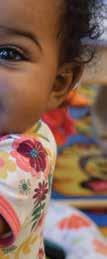








A creative prescription to encourage play during the rainy season
By Kathryn Mueller
We may be in the middle of our extended rainy season, but don’t let Seattle’s drizzle dampen your play plans — move your playdates indoors. When the weather takes a turn, I pack up my kids and let them run wild at these engaging play spots where their imaginations (and possibly a friend) are all they need to have fun. No rain boots required.
Pools with wild and winding waterslides. Miniature golf courses where you can ride atop a dazzling unicorn. Pottery shops where kids craft their own unique and colorful creations. I’ve got suggestions for all of these and then some. In fact, each spot will thrill your kids so much, they won’t even notice the weather outside.
The Snohomish Aquatic Center is a great option for indoor pool fun. The rave reviews speak for themselves; it’s arguably the best pool in town. Amenities include a large recreation lap pool, a lazy river, an interactive Spray n’ Play area for toddlers, a hot tub, a towering corkscrew waterslide more than 151 feet long, and a surf-simulation machine (the only one of its kind in the area).
To ride the water slide, children must be at least 48 inches tall and be able to pass a swim test. For little ones wanting to surf, they have to be at least 42 inches tall to ride the boogie boards, and 52 inches tall and less than 250 pounds to ride the stand-up boards.
Location: 516 Maple Ave., Snohomish

Our family recently visited the Lynnwood Recreation Center for its open swim, and my kids had an absolutely splash-tastic time. It has amenities for all ages, and the pool areas are massive. The center offers two large and winding waterslides, a splash pad and beach area for smaller kids, a lazy river with ample tubes, a diving board, hot tubs and a warm-water wellness pool (where my littlest and I spent the most time). There is a height restriction for the slides, so warn your tiny tots ahead of time if they are under 40 inches tall.
Children younger than age 6 need to be accompanied














continued from page 39
by an adult in the pool, so if you have a little one, pack your swimsuit. Reservations are required in advance. The pool is very popular on the weekends, so get there early even with a reservation. There will likely be a line to check in.
Location: 18900 44th Ave. W., Lynnwood
3/



11/13/23 11:25 AM






If you are looking for a traditional miniature golf course, this place might not be for you. If you want to ride atop a unicorn, putt into a UFO, dodge soccer balls while trying to get a hole in one, or pretend to be a queen or king on a giant iron throne, then this is the place. Par1 Minigolf’s holes are masterfully themed; it’s not your average putt-putt course. Grab a bite and play a round. Selfies are encouraged.
Plus, Par1 Minigolf is located at Lincoln Square. You can extend your trip by visiting the Cinemark movie theater or Lucky Strike Bellevue, which are just steps away.
Location: North Tower, Lincoln Square, 700 Bellevue Way N.E., Suite 300, Bellevue















4/ Flatstick Pub
Although Flatstick Pub offers a number of locations around Seattle, its South Lake Union location is our favorite. Whenever we go, we always take a selfie with the towering Sasquatch. The nine-hole mini golf course is wonderful for kids. It’s bright, inviting and challenging enough to appeal to a broad range of ages. We like to play board games and order pizza after a round of golf. For parents, the pub has an extensive tap list. Just plan to go early; after 7 p.m., it’s 21 and older.
5/ Paint Away!
Paint Away! offers a welcoming space for kids to create their very own work of art — and maybe get a bit messy. They can paint in the studio or take a piece of pottery to paint in the comfort of your home with its pottery-to-go program.
Location: 7345 164th Ave. N.E., Suite I-130, Redmond
6/ Glazed and Amazed
Located in the heart of Edmonds is a small walk-in pottery shop that we love to frequent. It offers a huge selection of pottery to paint, including seasonal treasures. Simply pick your pottery, grab a seat and paint away.
We love the events the studio offers, including preschool story time and kid’s night out. Reservations are required for kid’s night out ($61 per child). Drop off your little ones and enjoy a night out on the town in Edmonds while your kids have fun creating a pottery masterpiece. The studio provides pizza, snacks, a movie and activities from 6 to 9 p.m.
Location: 514 Main St., Edmonds

Summer ‘25 Registration opens february 15th 6/23 - 8/1





GLSA


continued from page 41
7/ The Slime Factory
If your kids love slime, this is the place for them. Donning their lab coats, they step into The Slime Factory to create their own slime. This hands-on experience lets kids get messy, allowing them to immerse themselves in goop while having a good time. They can choose from a variety of colorful slimes, and add their own scents, beads and charms to the mix. It’s a sensory experience kids won’t soon forget.



Admission is valid for up to 90 minutes. This activity is recommended for children ages 4 and older. Also note that there are no public bathrooms.
Location: 3929 Factoria Square Mall S.E., Bellevue




8/ Sky Zone Trampoline Park
A new attraction recently opened in Mountlake Terrace, and we had to bounce over to check it out. Sky Zone Mountlake Terrace is a large indoor trampoline park with more than 32,300 square feet of activities. My kids loved the unique and diverse array of offerings — there’s something for every age and skill level.













From the kids’ soft play area, perfect for smaller jumpers, to the high-flying zip line geared toward older kids (if you can reach the bar, you’re cleared for takeoff), everyone will have fun soaring, jumping and bouncing around. There’s also the iWall, a place where kids can enjoy immersive, interactive activities. My littlest jumper loved throwing balls at the wall.
In addition to Mountlake Terrace, Sky Zone has locations across the region, including Silverdale and Tacoma. At each location, you’ll find a mix of Sky Zone’s 60 attractions, such as the ninja warrior course, air court, trapeze and swing, and more.

9/ Kenmore Lanes
Kenmore Lanes is a massive bowling alley with 50 lanes. The bowling alley is also home to an arcade and the 11th Frame Restaurant and Bar. It’s recommended to call ahead to check lane availability and make a reservation. Are your kids avid bowlers? Kenmore Lanes offers a junior league on Saturdays for kids ages 4 to 19 years old.
Location: 7638 N.E. Bothell Wy., Kenmore


10/ Kraken Community Iceplex
Bundle up and head over to the Kraken Community Iceplex for fun on the ice. It offers public skating sessions for all ages and skill levels as well as a tot play hour geared toward tinier skaters. Tot play hour allows little ones to skate and play with piles of snow, with balls provided for extra entertainment. The iceplex has an option to rent skates and skate-aid seals. You can also wear sneakers or boots if skates feel too intimidating. Helmets are highly recommended.
Grab hot cocoa at the Starbucks after you skate. If you need more sustenance, take a seat at 32 Bar & Grill. The restaurant overlooks the ice rinks, so your meal comes with free entertainment. Location: 10601 Fourth Ave. N.E., Seattle ■
Kathryn Mueller is a mom of three and a transplant who fell in love with the splendor of Washington and now calls Shoreline home. She enjoys exploring Pacific Northwest trails with her children and toddling around the city for good eats and adventures.


Check out many more happenings online at parentmap.com/calendar
By Julie Dodobara

It’s a new year and a chance to wipe the slate clean for a fresh start. I look forward to filling the remaining noschool days with exciting new adventures, from exhilarating nature outings to eyepopping performances. And don’t miss your last chance to bask in the cheery glow of sparkling lights (when we need it most!) by catching the remaining brilliant light installations of the season. Happy New Year!
� Winter fun continues with gliding and sliding at seasonal skating rinks around town.
Skate at Bellevue Downtown Ice Rink through Jan. 12; at Lights & Ice at Tulalip’s Quil Ceda Village, also through Jan. 12; at Oly on Ice through Jan. 20; and at Snohomish Valley Ice Rink all the way until Feb. 2. Book your skate session online and plan to spend $10–$25 per person, including skate rental. If you’re a fan of indoor skating, check out Ice Lights, open until Jan. 4 at the Sprinker Recreation Center in Tacoma.
� Bring on the lights fantastic and extend your holiday sparkle into January by walking the Tacoma Light Trail, a series of light-art installations set up around downtown Tacoma and
— new this year — the Hilltop neighborhood and South Tacoma Way. Artworks will light up the dark and (otherwise) dreary nights Dec. 31–Jan. 12. Free.
� Perhaps you didn’t find the time or ideal weather conditions to visit WildLanterns before the end of the year. Good news — it’s not too late! Woodland Park Zoo’s enchanting WildLanterns show lingers into the new year, open Thursday–Sunday through Jan. 19. It’s a splurge, at $27.45–$33.95 per person, but your ticket purchase supports the animals in the zoo’s care.
� The holiday desserts have been gobbled up. Now it’s time to switch gears and get out and get moving. Washington
State Parks entices your family outdoors — bundle up! — with two free-entry days this month, Jan. 1 and 20, when you don’t need to display at Discover Pass to park. Fresh air, tall trees and winter wildlife await. If you plan an outing for New Year’s Day, take advantage of one of the many guided snowshoe or hiking excursions offered through the state’s First Day Hikes.
� If you want to guarantee a memorable start to the new year, defy the January chill and start 2025 with a very cold dip with the bravest members of your crew. Show up for one of the many polar bear plunges making a splash around the sound. You’ll find such events on Wednesday, Jan. 1, in
ParentEd Talk with Dr. Ned Hallowell
Online ParentEd Talks event
Seattle, Renton, Issaquah and Tacoma, to name a few. Times vary. Free or by donation.
� Use those eagle eyes to spot majestic flyers during the monthlong Skagit Eagle Festival. Visit the Bald Eagle Interpretive Center at Howard Miller Steelhead Park in Rockport, Washington, then join a free guided nature walk at 11 a.m. or 1:30 p.m. during weekends this month: Jan. 4–5, 11–12, 18–19 and 25–26.
� Resolve to embark on an outdoor adventure with the family, test your investigative skills and have a grand time. You and your squad will scour the Grandview Trail at Chambers Creek Regional Park search for eight of the usually elusive mythical creatures during the Sasquatch Hunt, Jan. 6–19. Successful searchers will earn a special prize.
� Join the Japanese American community on Bainbridge Island to ring in the new year the traditional Japanese way, at a celebratory mochi tsuki. The process entails cooking rice over an open fire, pounding it by hand using wooden mallets, and shaping it into cakes (mochi). Sample the finished product and enjoy traditional dance and taiko drum performances at Woodward Middle School, Saturday, Jan. 11, 11 a.m.–3 p.m.
� Our ParentEd Talks series welcomes ADHD expert and best-selling author Dr. Ned Hallowell, who will share his
31–Jan. 12 | Nightly
Tacoma Light Trail
Downtown Tacoma, Hilltop neighborhood and South Tacoma Way

personal insights about the unique gifts of ADHD, inviting families to shift thinking on neurodiversity and harness the strengths of kids with ADHD. Tune in live Thursday, Jan. 16, noon–1 p.m. or receive the recording to watch anytime. $10, or $50 for the entire 12-talk series. Members of partner schools join for free.
� Got any monster truck fans in your crew? Bring them to one of five shows at the Tacoma Dome between Jan. 17 and 19 to marvel at the epic stunts, big air and nonstop action performed on four giant wheels during Monster Jam. Favorite trucks Grave Digger, El Toro Loco, Sparkle Smash and others compete by racing, spinning, hopping and standing on two wheels. Tickets are $20 and up.
� It’s always a frosty good time at Hands On Children’s Museum’s annual winter fest, Ice Adventures, celebrating our coolest season. This
January, the museum invites us to “Embark on an Exciting Arctic Expedition” by learning to snowshoe, skating in your socks, racing ice cube skiers and more. The fun takes place Jan. 17–20, with special activities honoring Martin Luther King Jr. on Jan. 20. Fest is included with admission.
� Rock out to kindie faves the Not-Its, take part in a mime workshop, learn festive traditional Mexican dance moves
Jan. 18 | Saturday
Kidstock!
Edmonds Center for the Arts
and more at Kidstock!, the free, full-day arts celebration especially for families with kids of all ages. Join the fun at Edmonds Center for the Arts, Saturday, Jan. 18, 9:30 a.m.–3:30 p.m.
� Make it a family date night (or afternoon) and share a couple of hours of magic under the Big Top at Marymoor Park in Redmond during “Kooza,” the latest show from Cirque du Soleil. Expect lavish costumes, high-flying acrobatics, comedic clowns, as well as a special price for families of between four and eight members. The show runs Jan. 19–March 16. Prices start at $55.
� Honor the life and legacy of the Rev. Martin Luther King Jr. by joining the Northwest African American Museum at its annual King Day celebration, which will include notable speakers, inspirational performances, kids’ activities and giveaways. Monday, Jan. 20, 10 a.m.–5 p.m. Free admission all day. ■
Julie Dodobara is ParentMap’s calendar editor.
SPONSORED EVENT

Playful Winter Fun Every Week
KidsQuest Children’s Museum is here for rainy day learning moments. Build fabulous forts, play with clay, circle up for Story Time TUES & THURS 11am.
kidsquestmuseum.org

Find
By Tiffany Doerr Guerzon
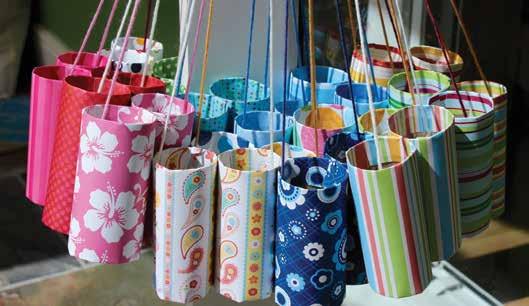
Children love to hear the same stories read over and over, so why not incorporate their favorite story time book into a birthday celebration? It’s easy if you’ve got a few inspiring ideas to build from. Plus, it comes with a built-in party favor idea: Give your guests the book to take home. Or add an unexpected twist: Ask guests to bring their favorite picture books to donate to a local shelter.
dragon tails craft and a roaring contest!
• “Pinkalicious”: For a perfectly pink party, the author of the Mommy of a Princess blog offers tips such as decorating the chairs with inexpensive pink butterfly wings, offering manicure and makeup stations, and serving pink cupcakes and pink snacks (of course!).





• “Going on a Bear Hunt”: Kids have been swishy swashy, splash sploshing through this tale for generations. The Mud Pie Fridays blog author shows you how she set up an outdoor adventure course with long, wavy grass, a deep, cold river and all of the other experiences from the book.
• “Dragons Love Tacos”: If you serve tacos at your birthday party, dragons will surely come, but if they eat spicy salsa … uh oh! Throw a fiesta-themed party based on this book (and its sequel, “Dragons Love Tacos 2”). All it takes is a taco-shaped piñata, a
• “The Cat in the Hat”: Hostess With the Mostest provides cute food suggestions to fit with this theme including blue Jello in clear cups topped by a red gummy fish, green deviled eggs and candycoated pretzel rods with red fondant bow ties! Decorate your party space with bright red, blue and white stripes and polka dots for a whimsical feel. ■
Tiffany Doerr Guerzon is a freelance writer and the thrifty mom of three children. When not writing, she can be found hiking in the woods near her home with her rescue dog Luna.















































































